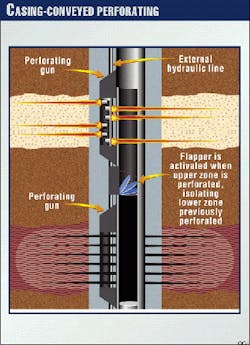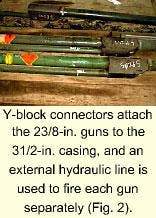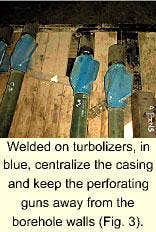Marathon Canada Ltd. has recently used casing-conveyed perforating guns to complete a gas well, Well 14-1-28-18, in the Drumheller field of central Alberta.
The novel completion program, in mid-August, involved running 3½-in. casing with externally attached perforating guns, isolation devices, pressure gauges, and remote signaling systems in a 71/8-in. borehole.
Radioactive tags were used to align the perforating guns, at various intervals, to a total depth of 2,543 ft. After the casing was cemented, four separate intervals were perforated at six shots/ft, individually fracture-stimulated with a low-polymer fracturing fluid, isolated with a flapper, and flow-tested in a single day. The perforating guns were actuated through an external hydraulic firing line. Fig. 1 illustrates the process.
Half of the externally attached perforating charges were oriented to shoot through the casing wall into the wellbore and then out through the other side of the casing into the formation. The perforating guns (Fig. 2, at right) were loaded with six shots/ft, with three charges aimed at the casing, and oriented at 22.5°. Turbolizers maintained the proper distance between the guns and the borehole (Fig. 3, below right). The three charges aimed opposite the casing were phased at 90°. The perforating event actuates the isolation devices inside the casing.
The zones were individually stimulated after each zone was perforated. During stimulation, a glass flapper valve isolated the zones below the one being stimulated. If required the flappers can be broken with coiled tubing or wireline tools.
During this field test, only 20 min elapsed between the frac jobs. The entire job of perforating and stimulation lasted 3 hr.
With this completion process, Marathon says it expects to realize a more effective way to stimulate each pay interval and reduce completion time and costs. It estimates that total completion costs in lenticular sand, multi-pay environments can be reduced by about 10-15%, and completion time savings reduced by 60% or more.
This technology, marketed as EXCAPE Completion Process, was developed jointly among Marathon Oil Co., BJ Services Co., TriPoint Inc., and Owen Oil Tools.



